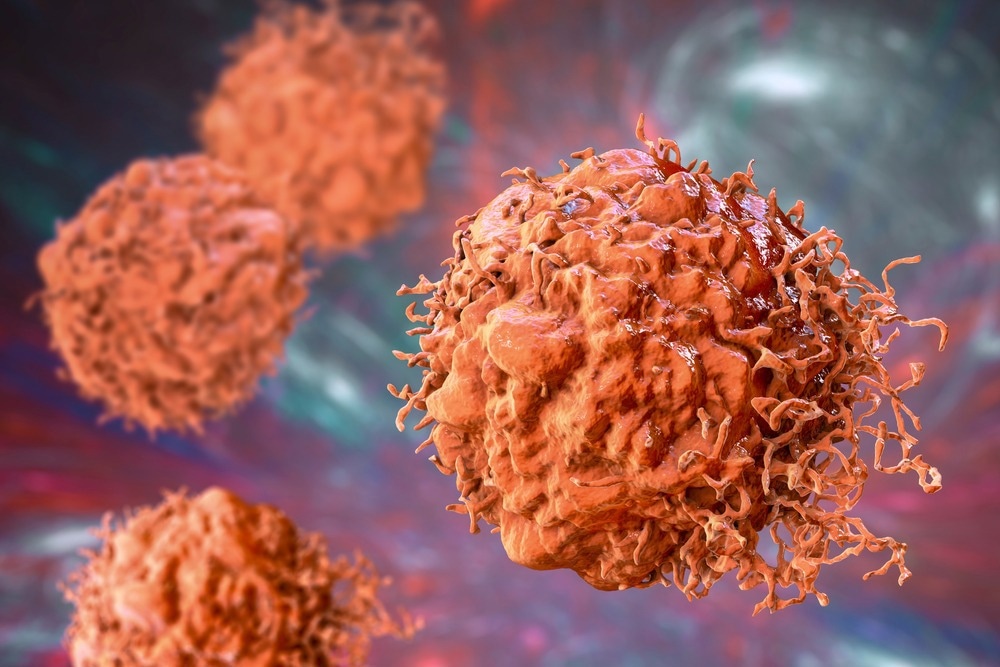Although retinoic acid (RA) can induce cell death, its weak anticancer efficacy limits its clinical applications. To this end, stimulus-responsive self-assembling prodrug-based nanomedicines are promising candidates that enable controlled drug delivery.

Study: Self-deliverable and self-immolative prodrug nanoassemblies as tumor targeted nanomedicine with triple cooperative anticancer actions. Image Credit: Kateryna Kon/Shutterstock.com
In an article published in the journal Biomaterials, unique chemistry was explored to maximize the therapeutic potential of RA, wherein aryl boronic acid was subjected to hydrogen peroxide (H2O2) to release quinone methide (QM). Furthermore, the generation of hydroxy benzyl alcohol (HBA) from alkylates glutathione (GSH) suppressed the expression of vascular endothelial growth factor (VEGF).
The boronated RA prodrug (RABA) was formulated into robust drug delivery systems that are self-deliverable nanoassemblies that released QM and RA via H2O2-triggered self-immolation manner to exhibit anticancer activities. Moreover, RABA nanoassemblies promoted apoptosis of cancer cell-mediated by reactive oxygen species (ROS).
The self-assembling prodrug-based drug delivery is beneficial for the excellent anticancer efficacy of RABA nanoassemblies. This strategy has provided new insight into the designing and development of self-immolating prodrug nanoassemblies for target-specific cancer therapy.
Prodrug Nanoassemblies as Drug Delivery Systems
Drug self-delivery based on nanoassemblies is a new paradigm for controlled drug delivery and efficient anticancer therapy. Moreover, this type of drug delivery allows intracellular delivery of drugs without the need for carriers, thus exhibiting nanoscale characteristics.
Molecular nanoassemblies involve an instantaneous assembling of small molecules to form well-organized nanostructures, while various noncovalent interactions are leveraged. Prodrugs are converted into active ingredients upon administration and enhance their therapeutic activity. Thus, prodrug delivery based on nanoassemblies involves modulation of the prodrug’s molecular structure to integrate them with molecular nanoassemblies enabling the formation of robust drug delivery systems.
These nanoassemblies are amphiphilic, possessing both hydrophilic and hydrophobic moieties, facilitating instantaneous assembly under aqueous conditions. Furthermore, the prodrug nanoassemblies formed enable controlled drug delivery.
RA plays a vital role in cell growth and differentiation and induces cancer cell apoptosis via cytotoxic activities. Moreover, RA is anticipated to enhance the efficacy of immune checkpoint inhibitors and antiangiogenic therapies. However, RA is inefficient in inducing cancer cell apoptosis compared to traditional anticancer drugs.
ROS such as H2O2 serves as a messenger in signaling pathways enabling tumor development. However, its excess presence induces damage to cancer cells leading to cell death. To this end, GSH is an antioxidant found in cells whose excess presence promotes tumor progression inducing therapeutic resistance to cancer cells.
Prodrug Nanoassemblies as Efficient Drug Delivery Systems
Boronic/boronated groups release the parent drug via an H2O2-triggered manner. Hence are used as a masking moiety for drugs in drug delivery. Aryl boronic/boronated groups connected to drug moieties via self-immolating spacer are oxidized in the presence of H2O2 to form QM through 1,6-elimination.
In the present work, the RABA hybrid prodrug was prepared based on self-immolating chemistry. Under H2O2 endogenous stimulus, the hybrid prodrug released pharmacologically active molecules (RA and QM). Furthermore, due to its amphiphilicity, RABA underwent self-assembly to form nanoassemblies in aqueous media, leading to a robust drug delivery system.
Since γ poly-glutamic acid (γ-PGA) was previously reported to bind to gamma-glutamyl transferase (GGT) with a high affinity, the RABA was coated with γ-PGA leading to tRABA nanoassemblies as drug delivery systems, employed as cancer-targeted nanomedicines. The synthesized tRABA nanoassemblies had a negative surface charge of -31 millivolts at pH 7.
Scanning electron microscope (SEM) results revealed that tRABA nanoassemblies were in the form of round spherical colloids with a mean hydrodynamic diameter of approximately 170 nanometers and polydispersity index (PDI) of 0.15. The tRABA nanoassemblies as efficient drug delivery systems showed excellent colloidal stability in the physiological solution, and superficial γ-PGA coating prevented protein adsorption on the tRABA nanoassemblies and aggregation.
The drug delivery and therapeutic actions of these tRABA nanoassemblies were triggered by endogenously produced H2O2. The therapeutic activity and translational potential of tRABA nanoassemblies were extensively investigated using mouse xenograft models and cell culture.
The results confirmed that the present work is a facile and highly efficient method to prepare hybrid prodrugs for their formulation into self-deliverable and self-immolating nanoassemblies as efficient drug delivery systems to exhibit synergistic anticancer actions and simultaneously overcome the limitations of carriers-mediated drug delivery.
Conclusion
To summarize, a self-deliverable and self-immolating drug delivery system, RABA was synthesized via a conjugation reaction between aryl boronic acid and RA. Self-assembly of RABA followed by coating with γ PGA resulted in γ PGA-coated RABA (tRABA) nanoassemblies, which released RA and QM in an H2O2-triggered manner inducing cancer cell apoptosis.
Furthermore, tRABA nanoassemblies targeted specific cancer cells that express gamma-glutamyl transferase (GGT). The in vivo studies on animal models demonstrated that the accumulation of tRABA nanoassemblies was specific to GGT expressing cancer cells that promoted the eradication of tumors.
The simple conjugation between boronic acid and RA allowed the formation of self-deliverable and self-immolating nanoassemblies. It led to triple cooperative anticancer activity and improved therapeutic potency of RA. With the help of the present work, tRABA nanoassemblies were demonstrated as potential drug delivery systems.
Reference
Jung, E., Jeong, S. W., Lee, Y., Jeon, C., Shin, H., Song, N., Lee, Y et al. (2022). Self-deliverable and self-immolative prodrug nanoassemblies as tumor targeted nanomedicine with triple cooperative anticancer actions. Biomaterials. https://www.sciencedirect.com/science/article/pii/S0142961222003210
Disclaimer: The views expressed here are those of the author expressed in their private capacity and do not necessarily represent the views of AZoM.com Limited T/A AZoNetwork the owner and operator of this website. This disclaimer forms part of the Terms and conditions of use of this website.